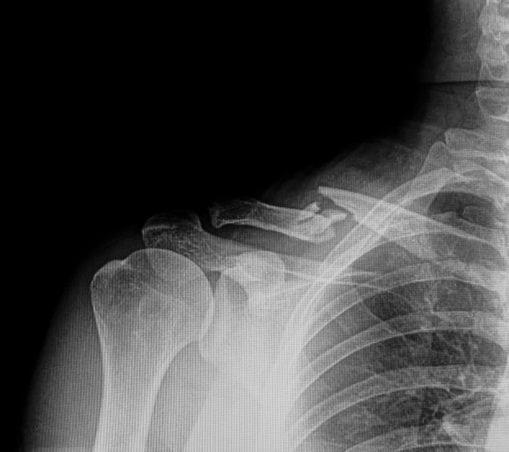Shoulder, AC joint, and clavicle trauma are among the most common bicycle crash injuries. When you fall from your bike, most often you land either on your outstretched arm (braced to catch you) or against your shoulder. This sudden impact places a tremendous force on the shoulder and injuries often occur. Shoulder separation, AC joint injuries, and fractured clavicles are common.
Any injuries incurred in a bicycle crash should be treated by a medical professional. Never choose to tough it out or push through without getting checked out. Injuries that are not treated appropriately can heal improperly and can affect your ability to cycle in the future. In addition, by failing to treat injuries, you set yourself up for ongoing pain and discomfort for months and even years to come.
Shoulder injuries are rarely severe and are usually easy to treat. But this does not mean you should not take them seriously. Some shoulder injuries do require surgery, and prompt medical attention is always appropriate.
Shoulder Separation
For a free legal consultation,
call 1-844-242-9253
The AC or acromioclavicular joint attaches the shoulder to the body. When you fall on your shoulder, the AC joint receives a tremendous blow. Even if you land on your hand and wrist, the impact in the shoulder can be tremendous. When the ligaments that hold the bones of the AC joint together are damaged, shoulder separation occurs. A shoulder dislocation refers to a separation of the ball-and-socket joint of the shoulder. Shoulder separation injuries range in grade from mild to severe.
Signs of AC Joint Injuries include:
Pain and swelling in the shoulder
Loss of strength in the shoulder
A bump or lump in the shoulder area
Decrease of range of shoulder motion
A popping or creaking sound when moving the shoulder
Pain with lifting, reaching, or passive movement of the shoulder
Fortunately, many AC joint injuries will heal on their own after a period of rest and immobilization. Slings are often prescribed to prevent movement in the shoulder. By supporting the arm and resting the shoulder area, use of a sling can rapidly relieve discomfort caused by the injury.
Clavicle (Collarbone) Fractures
Many cyclists report an audible crack when they fall, a sure sign of a broken clavicle. The collarbone is compressed when you fall, and fractures are common. Fractured clavicles can appear grim on x-rays, but rarely require surgery. Most fractures will heal within six to eight weeks. Full strength in the joint, however, can take an additional month or two.
Signs of Collarbone Fractures include:
Pain with shoulder movement
Swelling, redness, and bruising in the shoulder and collarbone region
A bump or bulge around the shoulder
Stiffness in the shoulder
Numbness or tingling in the arm or hand
Grinding or crackling that occurs with movement
Displaced fractures may require surgery in order to heal properly. During surgery, a plate is often placed in order to secure the bone together. Approximately 10 percent of individuals will have the plate removed at a later date, usually due to irritation.
See a doctor as soon as possible after your injury. Although most shoulder injuries are not life-threatening, there are some serious complications that can occur with fractured clavicles.
Pain Relief after a Bicycle Crash
Click to contact our personal injury lawyers today
Don’t be afraid to take painkillers, if prescribed. The pain associated with shoulder injuries can be severe. As athletes, we are accustomed to toughing it and pushing through the pain. But this is a case where you should go ahead and take the pain medication, if your doctor prescribes it. Intense pain can cause you to tense and tighten up your muscles, which only intensifies the pain. Taking pain relievers will allow you to rest appropriately. Never take more than the prescribed dose of pain medication.
Physical Therapy for Cycling Shoulder Injuries
Complete a Free Case Evaluation form now
Follow through with physical therapy. In most cases, your doctor will suggest a series of physical therapy appointments. The therapist will work with you to help you gradually regain full range of movement in your shoulder joint. After an AC joint injury, reaching and lifting may be uncomfortable. The therapist will work with you to help you regain your strength and ability to use your joint without pain.
Heat and cold therapy are often part of a physical therapy regime for a shoulder injured in a cycling crash. Your physical therapist may suggest that you apply ice or heat (or alternate the two) either at home or in a physical therapy office setting. Heat and cold therapy have been known to help relieve pain and reduce inflammation.
Your shoulders are important to overall functioning. Part of physical therapy may include strength and functional training. Your physical therapist will show you how to move appropriately and ways to avoid any undue stress on the AC joint.
Even if your doctor does not prescribe physical therapy, you can find a number of joint exercises and activities online. Just remember to start slowly and never push beyond the point of discomfort. Slowly build up your range of motion and level of activity until you return to normal.
The costs associated with AC and shoulder injuries from bicycle crashes can be tremendous. Between emergency medical care, imaging tests, surgery, and physical therapy, charges can be overwhelming. In addition to medical bills, some injured cyclists will require time off work or may not be able to perform their job for a period of time. We believe that cyclists who have been hurt through no fault of their own should be compensated for their injuries. If you have been injured in a bicycle crash, contact Kass & Moses today. Our attorneys have over 25 years of experience representing cyclists who have been hurt in crashes. Put us to work for you, starting with a free, no obligation phone call today.
Call or text 1-844-242-9253 or complete a Free Case Evaluation form


